richard carr
Western Thunderer
Jim and I met up at 7:30 on Saturday morning, we had decided to explore the railway by the Lake again, but starting out in the reverse order of last time. This meant heading to Fremont on US20. As expected, nothing was happening when we arrived, so we headed to Bellevue, as we parked up an NS heritage ACe went by with a train, we saw it but we didn't get a chance to take a photo.
Fortunately we didn't have to wait too long for the next train
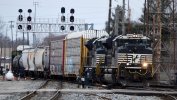
It's a pair of ACes. This was a very long train heading south to Columbus via Marrion.
While this was going by I saw this in the distance
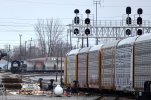
I've looked this one up, so I know it's an SD40-2 high hood, it was switching in the yard.
I could see a train in the distance to the south that had come up from Columbus, but it turned across us to join the line to Fremont. At the same time a train from the Fort Wayne line made it's way round to the Columbus line, about half mile away from us.
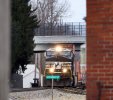
After this we decided to go and get coffee, it was pretty cold outside about minus 4 Celsius.
Of course it was bound to happen, we were driving back and went up one of the east side streets just a s a coal train entered the yard.
Then as were coming back to the rail park a train of autoracks was coming off the Fremont line. No I didn't manage a photo of either of these trains. Once it had past we checked the signals but everything was red and we decided to head to Sandusky
This time we went to where the mainline is crossed by the route to the docks and where the access to the yard is.
Again we had just parked up and I had to hurry to get my camera out to capture this
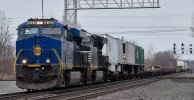
It's a GEVO meeting tier 3 emissions standards
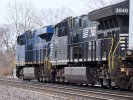
After that nothing for about half an hour by which point we were feeling hungry and went for lunch, but we did check the yard first and saw nothing.
Fortunately we didn't have to wait too long for the next train

It's a pair of ACes. This was a very long train heading south to Columbus via Marrion.
While this was going by I saw this in the distance

I've looked this one up, so I know it's an SD40-2 high hood, it was switching in the yard.
I could see a train in the distance to the south that had come up from Columbus, but it turned across us to join the line to Fremont. At the same time a train from the Fort Wayne line made it's way round to the Columbus line, about half mile away from us.

After this we decided to go and get coffee, it was pretty cold outside about minus 4 Celsius.
Of course it was bound to happen, we were driving back and went up one of the east side streets just a s a coal train entered the yard.
Then as were coming back to the rail park a train of autoracks was coming off the Fremont line. No I didn't manage a photo of either of these trains. Once it had past we checked the signals but everything was red and we decided to head to Sandusky
This time we went to where the mainline is crossed by the route to the docks and where the access to the yard is.
Again we had just parked up and I had to hurry to get my camera out to capture this

It's a GEVO meeting tier 3 emissions standards

After that nothing for about half an hour by which point we were feeling hungry and went for lunch, but we did check the yard first and saw nothing.





































